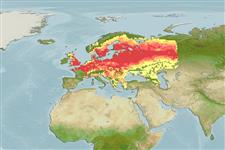এ্যাকটিনপটেরীজিআই (চেপ্টা-ডানার মাছ) >
Cypriniformes (Carps) >
Cyprinidae (Minnows or carps) > Cyprininae
Etymology: Carassius: Latinization of , karass, karausche, European crucian carp (Ref. 45335).
; স্বাদু পানি; ঈষৎ লোনা তলদেশ বিহারী; পোটামোড্রোমাস (Ref. 51243); গভীরতার পরিসীমা 5 - ? m (Ref. 2163). Temperate; 2°C - 22°C (Ref. 1672), preferred ?; 69°N - 35°N, 10°W - 169°E
Eurasia: North, Baltic, White, Barents, Black and Caspian Sea basins; Aegean Sea basin only in Maritza drainage; eastward to Kolyma drainage (Siberia); westward to Rhine and eastern drainages of England. Absent from North Sea basin in Sweden and Norway. In Baltic basin north to about 66°N. Widely introduced to Italy, England and France but possibly often confused with Carassius gibelio (Ref. 59043). At least one country reports adverse ecological impact after introduction.
আকৃতি / ওজন / Age
Maturity: Lm ? range ? - ? cm
Max length : 64.0 cm TL পুরুষ/ লিঙ্গ অনিধর্ারিত ; (Ref. 6114); common length : 15.0 cm TL পুরুষ/ লিঙ্গ অনিধর্ারিত ; (Ref. 556); সবের্াচ্চ প্রকাশিত ওজন : 3.0 kg (Ref. 556); সর্বোচ্চ উলি্ল্লখিত বয়স : 10 বৎসর (Ref. 59043)
পৃষ্ঠীয় কাঁটা (মোট ): 3 - 4; পৃষ্ঠীয় নরম পাখনা দন্ড (মোট ): 13-22; পায়ূ কাঁটা 2-3; পায়ূর নরম পাখনা্তুন্ড: 5 - 7; কশেরুকা : 32. Diagnosed from its congeners in Europe by having the following characters: body golden-green shining color; last simple anal and dorsal rays weakly serrated; 23-33 gill rakers; lateral line with 31-36 scales; free edge of dorsal convex; anal fin usually with 6½ branched rays; and peritoneum white (Ref. 59043). Caudal fin with 18-20 rays (Ref. 2196). No barbels. The third dorsal and anal-fin rays are strong and serrated posteriorly.
Adults occur in shallow ponds, lakes rich in vegetation and slow moving rivers. They burrow in mud in the dry season or during winter (Ref. 2163). Usually restricted to densely vegetated backwaters and oxbows of lowland rivers. Can survive at high temperatures and at very low oxygen concentrations during summer and under ice cover (Ref. 59043). Tolerates cold, organic pollutants, and low oxygen levels in the water (Ref. 30578). Feeds all day but mainly at night on plankton, benthic invertebrates, plant materials and detritus. Usually does not occur in waters with rich ichthyofauna and abundant predatory species, but very abundant in the absence of other fish species. Spawns in dense submerged vegetation (Ref. 59043). Marketed fresh and frozen; eaten fried, broiled and baked (Ref. 9988). Live up to about 10 years. There is a gradual but continuing extirpation in many water bodies, especially in Danube drainage and central Europe, possibly to due competition with introduced Carassius gibelio in non-optimal habitats (Ref. 59043).
Females spawn multiple times during the spawning period (Ref. 88808). Reproduction in May-June in shallow water with dense vegetation, eggs 130000-250000/female adhere to plants, hatch after 4-8 days (Ref. 2163). Individual female spawn with several males. Males follow ripe females, often with much splashing. Eggs are sticky and are attached to water plants (Ref. 59043).
Kottelat, M. and J. Freyhof, 2007. Handbook of European freshwater fishes. Publications Kottelat, Cornol and Freyhof, Berlin. 646 pp. (Ref. 59043)
IUCN Red List Status (Ref. 115185)
CITES (Ref. 94142)
Not Evaluated
Threat to humans
Potential pest (Ref. 13686)
Human uses
মৎস্য: অত্যন্ত বাণিজ্যিক ; এ্যাকুয়াকালচার (জলজ পালন) : বাণিজ্যিক; শিকারযোগ্য মাছ: হঁ্যা ; মৎস্যাধার / এ্যাকুয়ারিয়াম : বাণিজ্যিক; স্পশর্ী : occasionally
আরো তথ্য
সহযোগী ছবি সমূহStamps, Coinsশব্দ ক্রোমোজোমের ধরণ গতি সাতাঁরের কায়দা ফুলকা এলাকাOtolithsমস্তিস্ক সমূহদৃষ্টি
হাতিয়ার
Special reports
Download XML
ইন্টারনেট সুত্র
